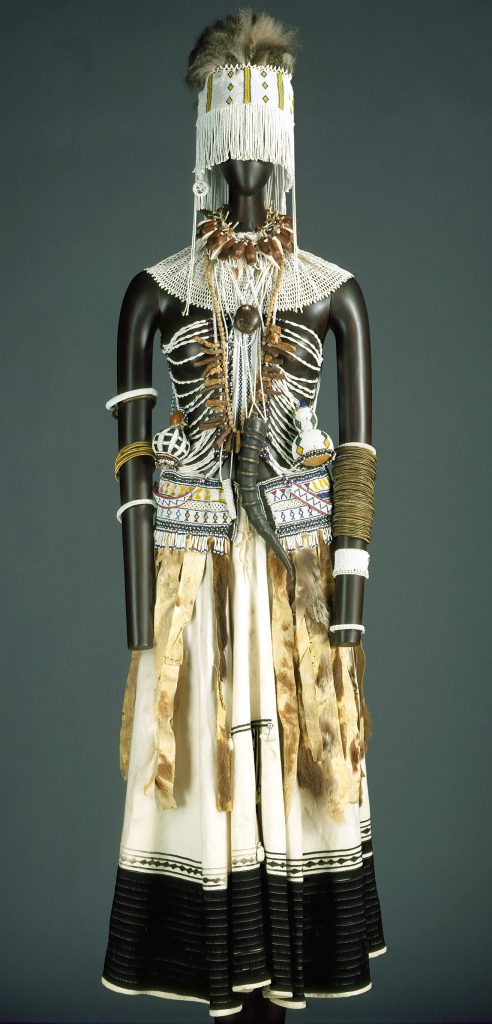Costume for a Female Diviner (Igqirakazi) (work of art)
Artwork Info
Key Ideas about this Work of Art
- This costume features a white wrap skirt trimmed in black, with arm bands, a patterned and beaded torso, and necklaces, including some with pendant gourds, which would have been filled with powdered herbal medicine. Strips of animal skin hang at each hip, and a headpiece topped with fur includes a veil of beads that the diviner would have swung or swayed in front of her viewers’ eyes, to induce a trance-like state (similar to hypnosis). The colors of the costume have symbolic meaning: white represents purity, and green and yellow represent fertility.
- The Xhosa people originated in the Eastern Cape of South Africa. They place importance on spirituality and rituals such as initiation, or the official process of joining a group. Traditional spiritual and religious beliefs of the Xhosa are often combined with Christianity, which was introduced by European settler colonists.
- The term “divine,” in this context, describes the action of foreseeing future events or discovering hidden knowledge (usually by interpreting omens or using supernatural powers). A diviner is a person who conducts ceremonies, serves as a healer, and communicates with ancestors through sacred dances, divination, trances, and dreams.
- The female diviner’s costume demonstrates that objects hold spiritual significance in African visual culture. It also shows how traditional practices are incorporated into modern life.
Learn More
Xhosa diviners communicate directly with ancestors and other spirits through trance, dream, and sacred dance, and they interpret the causes of illness and other misfortunes. Diviners conduct ceremonies and are skilled in using herbal medicine. Three times each year—marking the new year, spring planting, and harvest time—diviners and acolytes (diviners in training) perform dances to ensure success and good fortune. Dances are also held to mark the stages of training for acolytes, which lasts for five years.
This rare costume demonstrates Xhosa artistry in beadwork, and each part of the elaborate assemblage has symbolic and ritual meaning. For example, the white beads represent purity, and the green and yellow elements symbolize fertility. The amageza or swinging veil (also called “beads of madness”) would have been used by the diviner to induce a trance-like state, and the iselwa lembambo or beaded calabash (gourd) would have been filled with powdered medicine.
tags: ceremony, community, seasons, symbolism, women, movement
Additional Resources
Resources for Teachers:
- Watch a short film that explores the relationship between dreams and Xhosa ancestral divination.
- Read an article about beadwork in South Africa.
- Read an article about the Xhosa people of Zimbabwe.
Resources for Students:
- Read about Xhosa traditions.
- Watch a video about a beadworker and her journey.

